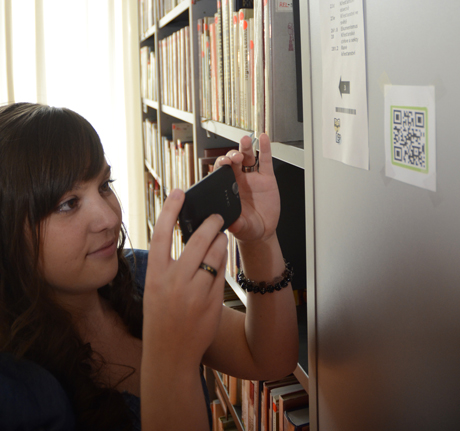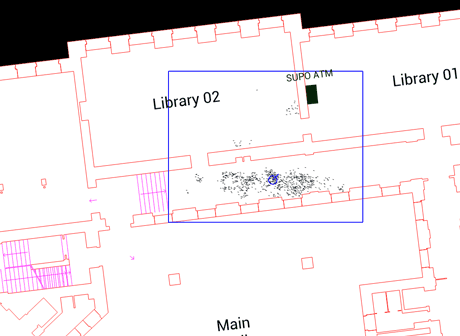by Jonáš Ševčík
The ability to easily access your location along with additional relevant information has emerged over the last six years with the rapid development of the smartphone industry. The trend of using mobile phones to get a sense of location is now one of the main features of these devices. Most outdoor tracking is done by the Global Positioning System (GPS), but what are one’s options if one is indoors, where you cannot use the GPS signal?
Navigation throughout vast complex buildings, eg, hospitals or school buildings, can be difficult even if the building is densely equipped with navigation signs. For acquiring location coordinates, the GPS can be used. This technique is commonly used in transportation and these days also in mobile phones to calculate coordinates on a virtual map. Although GPS tracking can be useful outdoors, it cannot be used indoors, because there is no direct visibility to GPS satellites.
Fortunately, there are other means for current smartphones to perform localization. They are equipped with various sensors such as magnetometer, linear accelerometer, gyroscope, and wireless network adapters. Even a low-end smartphone contains at least a magnetometer and an accelerometer. Therefore, there is now a unique opportunity to realize a solution for indoor localization.
At Masaryk University in Brno we recognized that opportunity, and have been developing an indoor localization for mobile devices. For our project we have selected the Google Android platform, which offers well documented platform tools enabling easy access to sensor data. In addition, developments for Android are mainly based on the Java programming language. Therefore, various already programmed libraries can be used.
Our localization system is based on algorithms published in [1, 2, 3]. The developed solution consists of three localization techniques merged together to provide more accurate results. The first technique is indoor tracking based on wireless networks. As presented in [1], we use the Received Signal Strength (RSS) fingerprinting to create a database of unified access point identifiers and their received signal strength which is mapped to location coordinates. RSS measurements at an unknown location are then compared to the signal strength maps to estimate the receiver’s location.
The second technique is dead reckoning – a process of calculating the current position by using previously determined coordinates, which are advanced by known speed and course. This technique is well known from air navigation. We use dead reckoning in an inertial navigation system, where the initial location is determined via the former technique. Alternatively, coordinates can be encoded into a barcode, which when placed into the position of those coordinates, can be scanned by a camera and then decoded. Position tracking is done by calculating a number of steps. Step length is estimated using a neural network as presented in [2]. The course of steps is determined by a gyrocompass. Since dead reckoning is subject to cumulative errors, we use barcodes for recalibrating a position (Figure 1).

The third technique is Sequential Monte Carlo filtering [3], which uses particles evenly spread in the probable location (as shown in Figure 2 by the blue rectangle) determined by a RSS fingerprint database. These particles are set in motion with events generated by step detection. Then these particles whose hypothetical motion leads through impassable obstacles, eg walls, are eliminated. This improves location estimation.

The indoor localization prototype is capable of displaying the position of a user on a floor map. The basic view offers display of walls, doors, staircases, and elevators. Additional information can be displayed using a set of layers, which contains points of interest such as room numbers, positions of vending machines, ATMs etc. Layers can be applied according to the needs of the user. This system is useful in unknown environments, providing users with crucial information about their location and helping them track their movement.
In a further development, we are planning to implement navigation to a selected point on the map. We will also extend view modes by introducing an augmented reality, which will allow users to perceive camera images enhanced by information about their surroundings.
The indoor localization prototype demonstrates that current smartphones are capable of difficult real-time calculations and that it is possible to implement a sophisticated localization system without using any additional hardware. This system provides guidance crucial for orientation in unknown buildings, where standard maps cannot be used.
References:
[1] A. Chen et al: “An algorithm for fast, model-free tracking indoors”, ACM SIGMOBILE Mobile Computing and Communications Review, ISSN 1559-1662, vol. 11 no. 3, 2006
[2] S. Cho: “MEMS Based Pedestrian Navigation System”, Journal of Navigation, ISSN 0373-4633, vol. 59, pp. 135–153, Royal Institute of Navigation, 2006
[3] M. Arulampalam et al: “A Tutorial on Particle Filters for Online Nonlinear/Non-Gaussian Bayesian Tracking”, IEEE Transactions on Signal Processing, ISSN 1053-587X, vol. 50 no. 2, 2002.
Please contact:
Jonáš Ševčík
Masaryk University - CRCIM, Czech Republic
E-mail:











